Summer 2011 part 3:
Utterly breathtaking Noctilucent Cloud display - amidst the downpours!
BACK
TO
WEATHER-BLOG
MENU
New!
Fine
Art
Prints
&
digital
images
for
sale-
Welsh Weather
& Dyfi Valley landscapes Slide-Library - Click HERE
INTRODUCTION:
THE PSYCHEDELIC OTHERWORLD
It's
July
9th and to be honest I'm still buzzing nearly a week after one of
the most amazing experiences in all the years I've been pointing my
lens at the skies. For some days prior to the night of July 2-3,
reports had been coming in from various parts of Europe of fine
displays of the "night-shining" Noctilucent Clouds, which as regular
readers may recall occur 80km up above the planet's surface at the
Mesopause, which marks the boundary between Earth's Mesosphere and
Thermosphere. NASA regards this zone as the re-entry altitude and the
International Space Station orbits within the Thermosphere: thus, these
clouds are right up there at the edge of Space itself, in a hostile
environment - the coldest place on Earth - where temperatures can fall
to -130C.
Conditions here in Wales had been pretty hostile too, but in this case
the trouble had been with clouds of a less interesting type -
low-level Tropospheric clouds, bringing grey skies and rain and
blocking any possibility of getting a look at the "Noctis". But as
Saturday July 2nd wore on, at long last the chances of clear skies were
looking increasingly good for the early hours of Sunday. A night-shift
was on the cards.
I've tried photographing these clouds on three other occasions with
varying degrees of success (depending on how one defines the latter).
There are several issues to take into account. Firstly, it's a
depths-of-the-night pursuit, so multisecond exposures are required.
Therefore, anything that
moves creates a big problem. The
camera can be stabilised with a tripod, but the biggest problems are
lower-level things closer to the camera that are moving, such as trees
(on a windy night) and ordinary clouds, which cause motion-blur. No
doubt, then, that a still, cloudless night offers the best chance.
Second, you
want a better view to the northern horizon than is available down here
in the
valley, hemmed in by high ridges. I reckoned that could be solved by
heading up into the hills to the south of the valley, courtesy of the
Machynlleth-Llanidloes mountain road.
Preparing for such an expedition is simple. A gallon of diesel in the
tank, camera battery fully charged, bracketing shut off, locate
headtorch and spare batteries, locate beanbag "tripod" (a knotted
pillow-case full of birdseed that can be plonked on any handy surface)
and then, somehow, manage to get to sleep by 6pm.
The alarm rang at 0100 on Sunday. Fighting off the appealing idea of
turning over and going back to sleep, I made strong coffee and a bacon
butty and checked for low clouds by looking outside, and
then double-checked by studying infrared satellite images on the Met
Office
website. All was clear: the mission was on. But would the Noctis show -
or not?
Just after 0200, on the upper part of the mountain road, I arrived
at the Wynford Vaughan-Thomas memorial, at the 460m contour and erected
a few years ago at what the famous broadcaster reckoned to be the best
view in Wales.
I'd like to think he would have been gobsmacked by the scene that now
lay before me. Across the lower third of the northern sky there lay a
delicate tapestry of whites, yellows and ice-blues, here coarsely
braided, there
as bands of fine ripples, against which the peaks of Cadair Idris, Dyfi
Forest and the Arans stabbed out sharply.
A gatepost close by suggested itself as a suitable place for the
beanbag. For the next hour and a bit, I alternately shot images and
gawped at the ever-changing scene, zooming in and out, tweaking the
camera's ISO and aperture settings and trying to eliminate any minute
fast vibration or slow drift of the camera that would blur the scene.
Finally, the eastern sky grew bright to the extent that the display,
bit by bit, started to fade and then vanish.
It had now
gone 0330 BST and by the time I arrived back in Machynlleth
it was well and truly light. On Maengwyn Street, the last of the
Saturday night drinkers were congregated around a bench, cans in hand.
I expect they'd been having a lively time, too. Up there, though, I had
been in some kind of strange, almost psychedelic Otherworld - all down
to atmospheric chemistry and physics, but then I am a firm believer in
Nature's ability to outdo any manmade pharmaceutical when it gets its
act together. Perhaps I am in a minority when it comes to such beliefs.
The other day, I printed the best
image out and showed it to some locals at the pub. Someone asked,
completely without any sense of irony,"bloody hell - what were you
smoking when you took that?"
|
THE RESULTS
These were all taken with a Nikon D300 with an 18-200mm Nikkor zoom,
shot with Aperture Priority at ISO 800 and below. To begin with, the
display was not massively bright but the brightness steadily increased
with time. The images variously show, from left to right, Cadair Idris,
the Dyfi Forest and the
Arans, topped by the 907m high Aran Fawddwy, which dominates the shots
below as it was situated under the best part of the display:
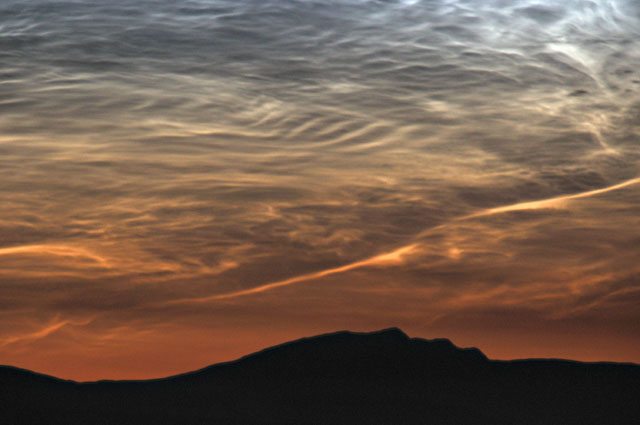
The display got brighter:
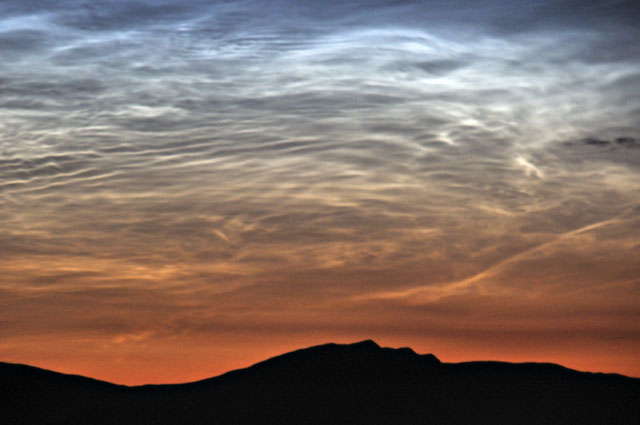
And zoomed-out - Arans (R) and Dyfi Forest (L):
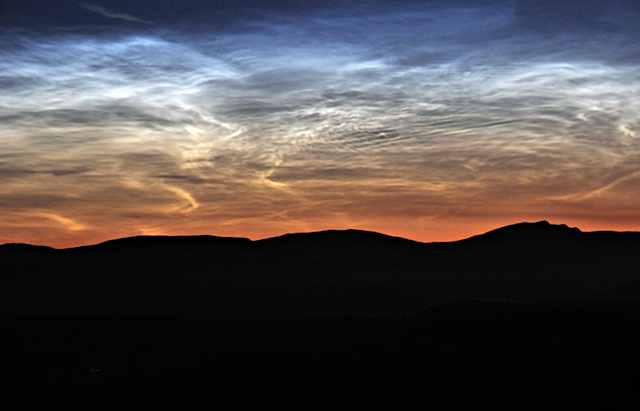
Neat ripple-effects
appearing:
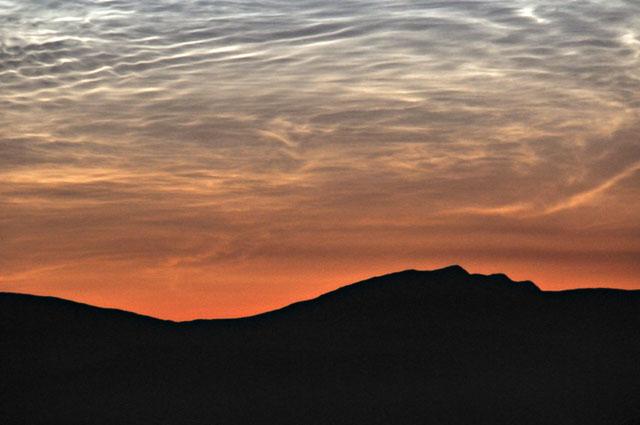
I had been holding the camera, wedged into the beanbag, but some minor
blur
was still occurring with some of these multisecond exposures, which did
not do
the scene justice. So next time I very carefully pressed the shutter
and stepped back, leaving the camera to do its own thing. The result:
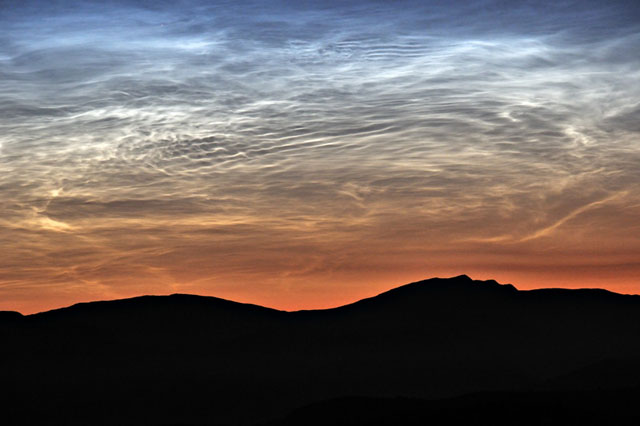
Much better - the image looks good on-screen resized up to 36 x 24".
The display continued to brighten as I continued shooting:

Zoomed-out
again:

And zoomed right out:
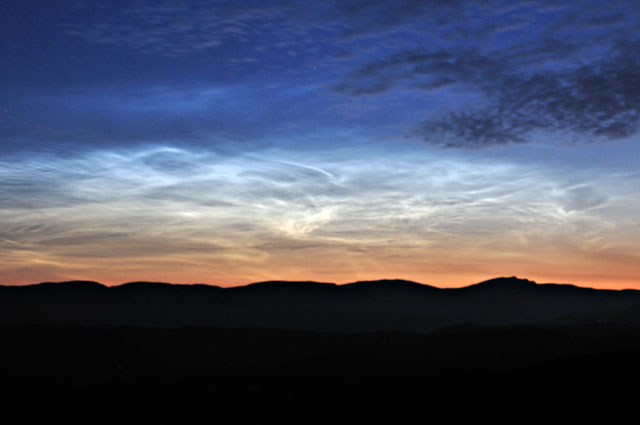
Cadair
Idris
to
the LHS of the display required a much longer exposure, for
which a heavy standard tripod should have been used. Of several
attempts, this one is not too bad:

Back to the main event:

Constantly changing in its subtle detail, with more neat rippling
effects top R in this one:
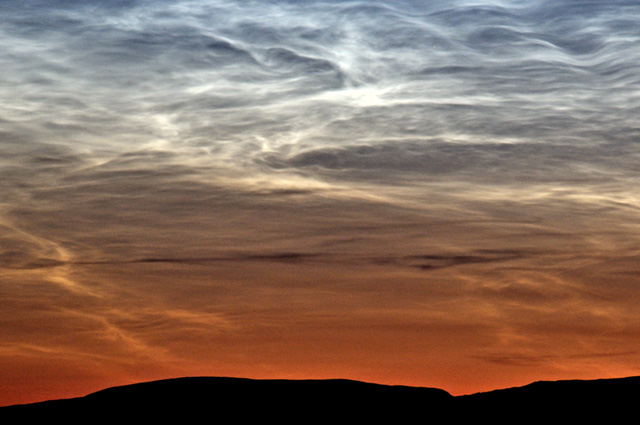
In the east, the sky was now brightening, but due north the display
continued.....

...before fading with the coming dawn:
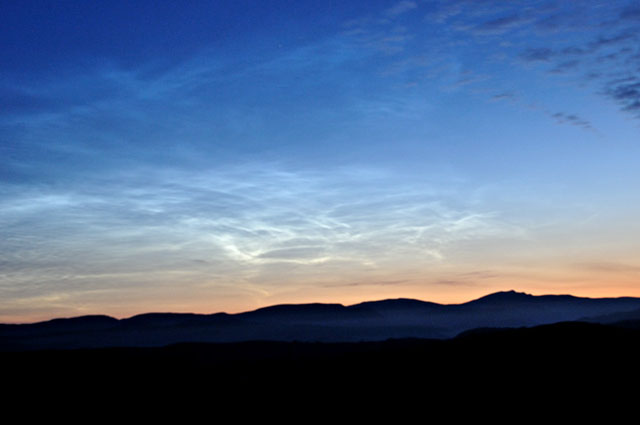
Arriving home, I downloaded the images, sorted out the best and sent
them to some
media contacts, but have heard nothing, which is rather unusual: having
said which, it has hardly been a "usual" week in the media!
Either side of that exceptional night, wet conditions have prevailed,
including a near-flood on the Dyfi, bringing down all sorts of debris
from twigs up to tree-trunks:
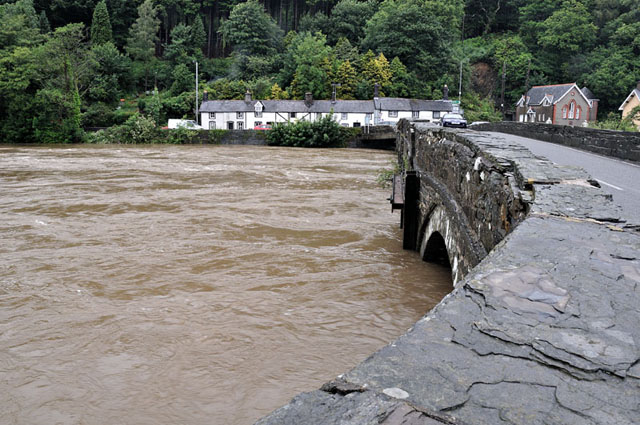
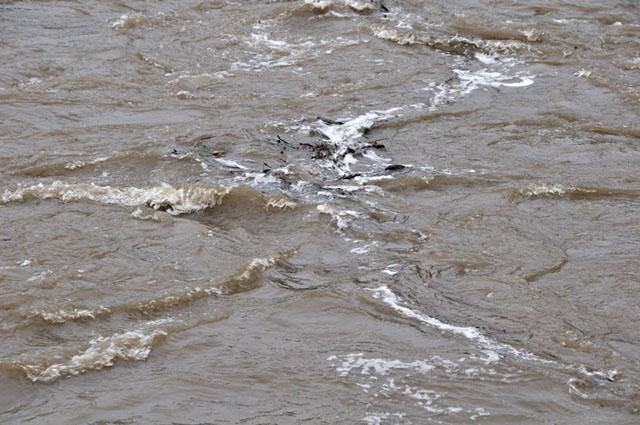
July 8th,
a thundery day in many areas, saw an active train-echo develop in a
SW-NE line from near Llangurig up past Llanidloes and towards Newtown. Train-echoing
occurs
when thunderstorms repeatedly develop and move along
convergence-lines (where wind-currents come together): like trucks
going
along a railway, the affected area gets one storm after another over
several hours (a big factor in the cause of the 2004 Boscastle flood).
The "echo" bit of the term refers to the radar returns that depict
where storm activity/heavy rainfall is occurring.
I had a busy
day but was able to get over to a favourite vantage-point near
Trefeglwys for the later afternoon show. The image below
shows part of the line of storms. Not at all impressive in photographic
terms, they nevertheless put on a good display of lightning, with
strikes occurring about once a minute. Twenty minutes or so later the
line was a bit closer, with the lightning now quite near and the
thunder ka-booming as it echoed from hill to hill. Storm-hunting isn't
just about the photography - it's a complete overload of the senses on
a good day!

On the way home an hour later, after things had quietened down, this
was the retrospect of the area, complete with lamb trying to hide
behind a thistle!
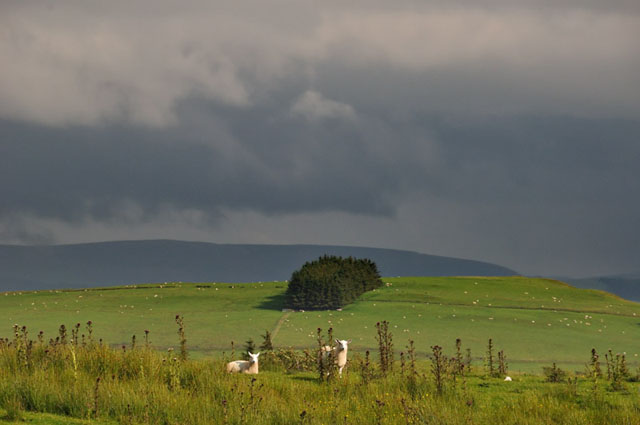
But beneath that grey pall, a drama was
unfolding:
according to BBC Wales:
"One person was evacuated
from their home in Powys following heavy rain, which also affected
roads. Firefighters helped the person to safety in Cwmdu, Llanidloes,
after receiving 10 calls from concerned residents from 1700 BST on
Friday. Three crews were trying to divert flash flood water from homes.
Traffic Wales, the Welsh
Government's travel service, said the A470 Cwmbelan bypass at Llangurig
was partly blocked, but the water has now receded. The road was
affected by flood water between the A44 (Llangurig) and B4518
(Llanidloes). One resident said road conditions north of Llanidloes
were "extremely bad" with water coming down from a nearby hillside."
One thing that sets Noctilucent Clouds apart from the other variants of
unusual/severe weather that I go after is that, so far as I can tell,
they don't do any damage!
More soon....
|
BACK TO WEATHER-BLOG MENU
New!
Fine
Art
Prints
&
digital
images
for
sale-
Welsh Weather & Dyfi Valley landscapes Slide-Library - Click HERE |
|
|
















